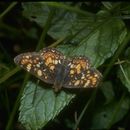en
names in breadcrumbs


US Federal List: no special status
CITES: no special status
Ecosystem Impact: pollinates
Phyciodes campestris larvae feed communally until half grown and then again during winter months. Caterpillars feed on various asters (Aster and Machaeranthera species) throughout their development. As the field crescent matures into an adult, flower nectar -a solution of sugars, water, and occasional amino acids, becomes the primary source of nourishment.
Plant Foods: leaves; nectar
Primary Diet: herbivore (Folivore , Nectarivore )
The field crescent butterfly spans the shores of the Arctic Ocean from Canada south to Mexico. This species is most commonly spotted flying at low to middle altitudes in the Rocky Mountains, and in higher mountains of the Northwest United States. Phyciodes campestris occupies central Alaska, the Mackenzie District of the Northwest and Saskatchewan territories in Canada, California, Arizona, New Mexico, as well as the western edge of the Great Plains.
Biogeographic Regions: nearctic (Native )
This species lives in flat open areas such as fields, meadows, forest clearings, grassland valleys, and swamps. The field crescent also dwells along canals and streamsides. In the northern part of the geographic range, Phyciodes campestris can be found almost anywhere, from plains to mountains, as well as in taiga -a broad subarctic band where the winters are long and cold. In the far northwestern part of its range, the habitat changes into arctic-alpine meadows, and fell-fields.
Habitat Regions: temperate
Terrestrial Biomes: taiga ; savanna or grassland ; scrub forest ; mountains
Other Habitat Features: riparian
The field crescent butterfly is generally quite small with a wingspan of 1 -1.5 inches (2.5-4.5 cm). The wings on the upper side are orange and brown with black margins, spots, and lines, while the underside of the wings reproduce these same spots in paler tints. The under side of the forewing is yellow-brown with a yellow arch at the cell, and the under side of the hindwing is yellow-brown with rusty markings. Of the spots on the underside of the wing, the most characteristic of Phyciodes campestris is the pale crescent situated on the outer margin of the hind wing. This spot is frequently pearly-white or silver colored.
Eggs are a pale-yellow-green, and are always longer than broad, with the surface at the base more or less pitted giving them a thimble-like appearance.
Phyciodes campestris larvae are patterned a darker, blackish brown with black heads. Weak cream dorsal strips and a lighter crescent strip adorn the body and eyes. They have tubercles arranged in regular rows.
The chrysalis, a protective structure during pupation, is a light mottled grey to brown, pendant shaped, and has small bumps along the dorsal region of the abdomen.
Range wingspan: 2.5 to 4.5 mm.
Other Physical Features: ectothermic ; bilateral symmetry
Males patrol just above the meadows during the day in search for females. After mating,females slowly flutter through the vegetation looking for a place to lay their eggs.
The eggs are a pale-yellow-green, laid singly in large clusters on the underside of host leaves, especially on young plants.
Key Reproductive Features: sexual ; fertilization (Internal ); oviparous
After eggs are layed on a suitable host plant, there is no further parental investment.
Parental Investment: pre-fertilization (Provisioning, Protecting: Female)